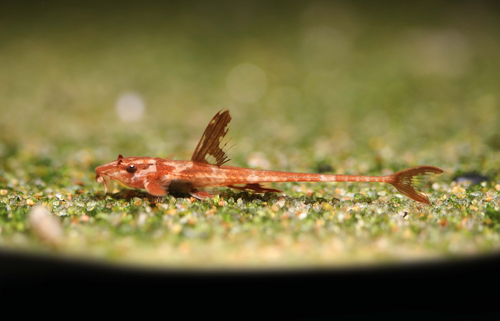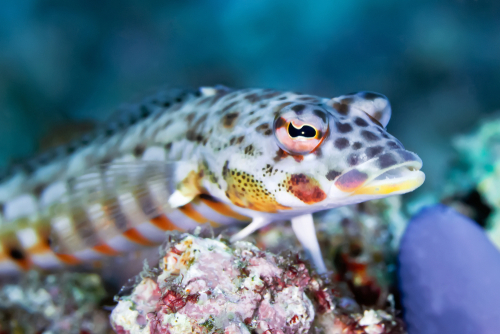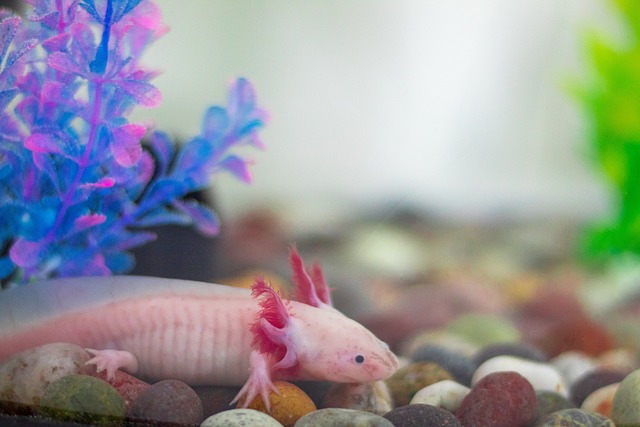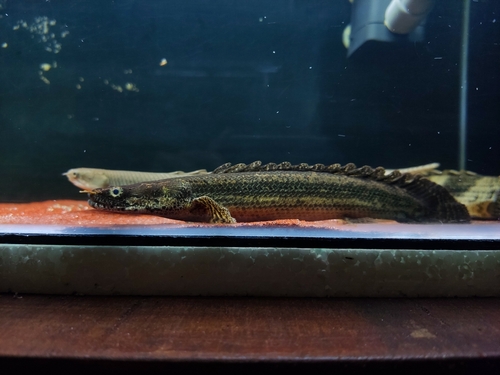No, you’re not seeing things – there really are quite a few different species of fish that look like lizards!
Some of these fish have lizard-like heads, others have lizard-like tales, and others still – like the Mexican walking fish we highlight below – look so much like a lizard that researchers for the longest time thought it actually was a reptile.
To shine a light on these fish we breakdown six of the most popular fish on the planet that look just like lizards, digging deeper into their main characteristics, what it’s like keeping them in an aquarium (whenever possible), and the major differences they have with the lizards they look so much like.
Shall we get right into it?
Let’s go!
Contents
Fish That Look Like Lizards
Similar posts:
- Popular Red Fish With Big Eyes
- Popular Fish With Four Legs
- Popular Fish That Look Like a Stingray
- Popular Black Fish With White Spots
1. Whiptail Catfish

The whiptail catfish is a perfect example of fish that look like lizards but still retain a lot of their “fishiness” as well.
Relatively small fish (the average length of a whiptail catfish is about 5 inches or so when fully grown), it’s not hard to confuse this fish with a bottom feeding lizard – or a bunch of twigs and branches, for that matter.
A nocturnal creature that loves to hover in the lower parts of the water column (just the same way as most catfish will), you’re usually going to find this fish in the rivers of South America gobbling up food as they come across it.
About as peaceful a catfish as you’re going to find, these fish are relatively simple and straightforward to keep in a freshwater aquarium.
Hardy, these fish can do well in water temperatures of between 77° and 82°F and are going to be happiest in water that has a pH balance between 6.0 and 8.0. Water hardness should be anywhere between five and 20°H.
Though these fish can sometimes be territorial they are not aggressive. When another fish encroaches on their territory they might put on a little bit of a show, but they’ll scramble back into the structure of the tank rather than fight.
Best of all, when these fish are kept well fed and in healthy water conditions you can expect them to live anywhere between five years and eight years – and maybe even a little longer than that.
The skin color and the armor like scales on these catfish give them a real lizard-like appearance. The bone structure (especially in the face and the body) resembles a lizard, too.
2. Lizardfish

Lizard fish makeup a huge family of marine life, representing more than 57 individual sub species that all share the same kind of characteristics and core features.
The inshore lizardfish is the most commonly kept lizard fish, a fish that does quite well in aquariums (as long as folks are able to keep water conditions dialed in).
This fish looks a ton like a lizard. The head shape, the eyes, the color, and the overall body shape of the lizard fish is a dead ringer for many reptiles that are found all over the world today.
On top of all of that, lizard fish have very sharp teeth like so many lizard species do – and they are carnivorous just like a lot of lizards, too!
Of course, lizard fish do not have four legs but instead have a big dorsal fin right in the middle of their back. These fish also do not have the unique ability for some lizards to regenerate parts of their body if they become detached or separated.
Those that want to keep lizard fish in captivity are encouraged to get larger tanks. This fish can grow to be up to 11 inches all on its own (which means you want to have at least 90 gallons of water for it) – and they can be a little on the aggressive side of things (not to mention pretty predatory).
All that said, taking care of these fish is about as simple and as straightforward as it gets when you’re talking about fish that look like lizards, anyway!
3. Axolotl

When it comes to fish that look like lizards there’s one species that pops into almost everyone’s mind, and that’s the axolotl – otherwise known as the Mexican Walking Fish.
This thing looks almost exactly like lizards you’ll find crawling around all over the world. It sort of looks like an oversized salamander (and actually has close cousins in the salamander family), but is very much a fish native to freshwater lakes all around Mexico City.
At first glance you’d be forgiven for thinking that this fish was a lizard. After all, it has limbs just like a lizard (complete with fingers and toes) and it has a pretty long tail, too.
On top of that, this lizard fish also has the unique ability to regrow parts of its body that become damaged or dismembered. There aren’t a lot of other fish out there that have this capability, especially not ones that look so much like a salamander to boot!
As if those similarities weren’t enough you’ll also be surprised to learn that axolotl reproduce by laying eggs just the same way that lizards do. Some fish also lay eggs (a different kind of egg, of course), but axolotl eggs are a lot closer to reptile eggs than anything else.
If you are interested in keeping this kind of lizard fish in an aquarium you’ll want to have at least 20 gallons of water for them to work with. Keep water temperatures between 60°F and 70°F, pH levels between 6.5 and 8.0, and make sure that these fish are kept separate from any others – including other axolotl.
That’s the kind of environment these fish need to thrive, and environment that gives them an estimated lifespan of anywhere between 10 and 15 years and the ability to grow up to 18 inches in length.
4. Bichir

An ancient family of fish that look a whole lot like different reptiles, these fish live in freshwater habitats throughout the more tropical regions of Africa (especially in the swamps and floodplains near the Nile River).
The head and mouth of these fish sort of look like a cross between an iguana and a dinosaur, giving them a real lizard-like aesthetic – especially when you add in the spiny fins that go along their long body and tail.
It’s not at all unusual for these fish to get up to 20 inches in length on average, though there are some in this family of lizard fish that can grow even larger. We are talking double that, hitting 40 inches in length pretty consistently.
The facial structure and spiny fins of this fish aren’t the only lizard-like features that they have, though.
Bony scales cover the body of these fish, protecting them like a suit of armor but also making them feel a lot like lizards feel as well.
Folks that are interested in keeping these kinds of lizard fish in an aquarium should understand that they aren’t a “set it and forget it” kind of pet. They need larger tanks (90 gallons at minimum), can live between 15 and 20 years, and have a reasonably aggressive personality.
If you’re going to keep them in a tank with other fish it’s not a bad idea to make those fish relatively peaceful. Catfish are great companions.
5. Deepsea Lizardfish
This deep-sea lizard fish is a funky looking fish, sort of like a cross between an eel, a lizard, and a dragon!
Found in some of the deepest depths of the ocean (we are talking depths of between 600 m and 3500 m), these fish have flat heads, sharp teeth, and a lizard-like mouth and eyes that make them look more than a little bit like a prehistoric dragon.
These fish, in a wide array of colors. We’re not just talking about muted whites, grays, and browns, though. These fish can be almost phosphorescent, with beautiful violet, blue, and indigo colors marking up their tough, armor-like scales.
Incredibly predatory animals, these fish are always on the hunt for their next meal and aren’t shy about biting into pretty much anything and everything they come across. That includes other deep-sea lizardfish!
For obvious reasons these aren’t often kept in captivity, especially not in home aquariums setups.
Tiktaalik Roseae
Now extinct, this fish spent a tremendous amount of time zipping around the waters of Canada up to 375 million years ago and shared a tremendous amount in common with lizards.
The archaeological record regarding these fish is pretty expansive, giving us a lot more information about these “lizard fish” that we simply wouldn’t have known about otherwise.
For example, we know that these fish had large, triangular, flattened heads that made them look a lot like a lizard up front. These fish also had larger and longer fins that sort of looked like legs, further adding to the lizard-like aesthetic.
These fins were so strong (and the rest of the internal bone structure so dense) that researchers believe these fish would “stand” at the bottom of slow-moving rivers and lakes just like lizards might.
And that’s not where the lizard similarities end, either!
Researchers now believe that these fish eventually evolved into a number of lizard species. This fish likely had lungs as well as gills, may have eventually made it onto land, and could have turned into some of the reptiles that we know today over millions and millions of years.
Closing Thoughts
The oceans, lakes, and rivers of our world are absolutely teeming with fish – including tens of thousands of species that have yet to be discovered.
Many of these fish have unique appearances that make them look like other animals that live on land, including fish that have a lizard-like aesthetic.
The ones we highlighted above are just some of the best examples of fish that look like lizards, including a whole host of these special fish that you can keep in your own home aquarium (for the most part).
If you really want the most lizard-like fish for your home aquarium set up, though, stick to the axolotl. The Mexican Walking Fish is about as lizard-like as you’re going to get!
Frequently Asked Questions
Are fish that look like lizards really fish, or are they reptiles?
All of the fish that look like lizards we highlighted above are actually fish, not reptiles, even though they may look almost identical to more than a few species of reptile that spend most of their time on land.
The Mexican Walking Fish is the perfect example of a lizard looking fish that isn’t a lizard at all. It could stand in as a 1:1 replacement for a bunch of salamanders, that’s for sure!
Can any of these lizard looking fish live on land?
The lizard looking fish we highlighted above are all going to need to spend the overwhelming majority of their time underwater. Some of them have the ability to “breach” the surface of the water for a short amount of time, but none of them are adapted to live for any length of time out of water.
At the end of the day, these fish are still fish and they need to be in water conditions that they have adapted to (regardless of whether or not that’s in the wild or in an aquarium somewhere).
Is it possible to keep lizard looking fish in a home aquarium?
Absolutely! Almost every single one of the lizard looking fish we highlighted above are able to be kept (without too much extra effort) inside of home aquariums.
Some of them need a little more space than others – we are talking up to 90 gallons tanks just for themselves – and some require a bit more hands-on care than the rest of the bunch.
The only two fish from the list above that you won’t be able to keep in a home aquarium would be the Tiktaalik Roseae (because it’s extinct) and the deep-sea lizardfish (because it’s so big, so dangerous, and lives at incredibly deep pressurized depths).

Ian Sterling, founder of Fishlab.com, began his aquarium journey over 30 years ago, driven by a deep fascination for fish and their diverse personalities. His website, Fishlab.com, is dedicated to making fishkeeping accessible and enjoyable, offering beginner-friendly guidance, expert insights, and a community for aquarists to connect and share experiences.

